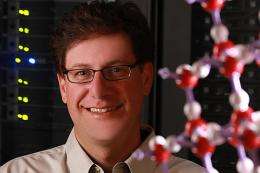Powerful computers, experiments provide insights into ion's behavior near interfaces

(PhysOrg.com) -- From renewable energy sources to pharmaceuticals, iodide ions are a common actor, and now, thanks to scientists at Pacific Northwest National Laboratory, the ion's behavior can be better predicted. By considering electrons' subtler choices about where to reside, Dr. Chris Mundy and Dr. Marcel Baer showed the negatively charged iodine ion congregates at the air-water interface. However, the ions gather at a lower concentration than previously predicted.
The team obtained answers about the iodide ion's choices to be at the surface or under bulk solvation, surrounded by liquid, using the laws of quantum mechanics in conjunction with Newton's laws of motion to describe the evolution of aqueous electrolytes, or salty water. The aforementioned calculations were extensive and required the use of leadership-class computers through the Department of Energy's INCITE award. Previous studies relied on empirical potentials, which are simpler mathematical models of molecular motion that do not explicitly consider quantum mechanics.
Understanding the nature of ions where air and water meet and at similar interfaces could change how we conduct basic energy research, climate studies, and biological investigations. However, the fundamentals of an ion's propensity to be present at an interface and the important interactions that wrap ions in liquid are still not understood. This research sheds new light on the effects of ions in the vicinity of hydrophobic environments.
"Our work shows where some models may fail and where you may have to take into account the more subtle effects of electrons when performing calculations," said Mundy, the physical chemist who co-authored the study.
It begins with large polarizable anions, negatively charged particles where the electrons slosh back and forth around the atom's central core in response to nearby electric fields produced by the motion of surrounding water molecules. The new conventional wisdom since 2002 is that these ions can exist in significant population at the air-water interface. The now nearly universally accepted results were pioneered by Dr. Liem Dang at PNNL and independently by Profs. Jungwirth and Tobias at the University of California at Irvine. These studies were done using empirical potentials in conjunction with a parameterized model for how electrons respond to different charged environments, namely polarization.
"Simply put, electric fields felt by an ion at the interface are different than those felt in the bulk of the liquid," said Mundy.
The earlier results have influenced a generation of both experimental and theoretical studies dedicated to understanding this phenomenon. Although there is now a consensus regarding ions at interfaces Mundy and Baer wanted to understand the precise interactions that drive ions to the air-water interface.
To understand how ions adsorb onto surfaces and provide the more accurate data to scientific models, the researchers integrated experimental research, theory, and leadership-class computing. The researchers performed extensive density functional theory calculations to mathematically represent the electrons and ions and determine their interactions.
To justify the computationally expensive calculations, the team compared the detailed structure of iodide in water to extended x-ray fine structure experiments conducted by John Fulton at PNNL. Results of this joint theoretical and experimental study suggested that quantum mechanical models reproduced the local solvation structure of iodide more accurately than the models based on empirical polarizable interaction potentials, known as multipole expansions. Here, a multipole expansion breaks down a complicated arrangement of charges into concepts, such as a monopole, dipole, etc., and is a good description when you are looking at charges from far away.
"Multipole expansions are good from far, but far from good," said Mundy. When it comes to the movement of the electrons and where electrons from different atoms overlap, the expansions don't provide the precise answers scientists need.
This study took advantage of the synergy between computational and experimental science. "Our result would not mean anything without the experimental results," said Baer, a Linus Pauling Distinguished Postdoctoral Fellow at PNNL. "It would just be another number with no weight."
The researchers continue to combine electronic structure, statistical mechanics, and leadership-class computing to assist in understanding the effects of iodide and other ions. This research will be continued by Mundy at PNNL and by Baer for the rest of his stay at PNNL and when he returns to Europe.
More information: Baer MD and CJ Mundy. 2011. "Toward an Understanding of the Specific Ion Effect Using Density Functional Theory." Journal of Physical Chemistry Letters 2, 1088-1093. DOI: 10.1021/jz200333b
Provided by Pacific Northwest National Laboratory


















